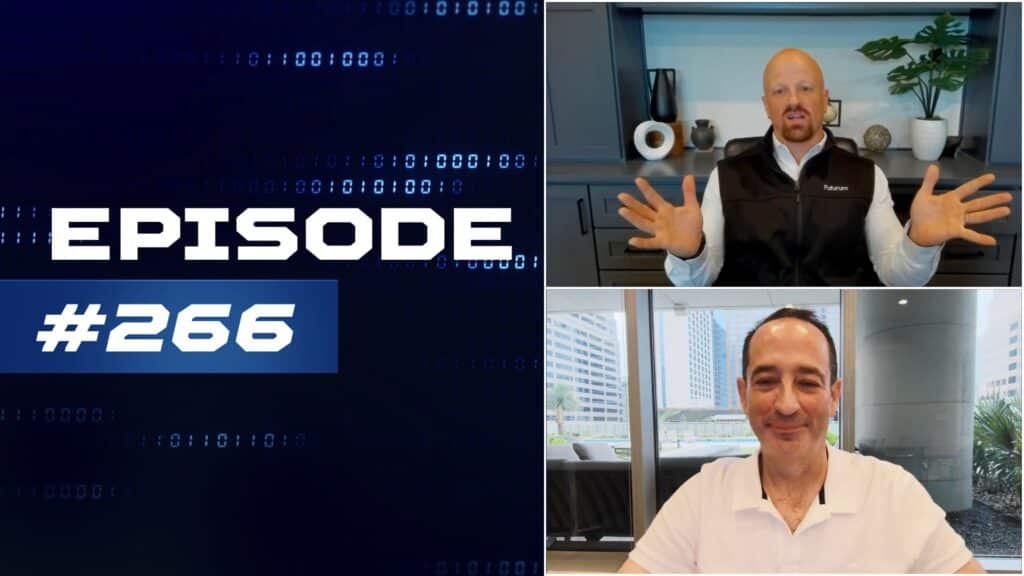Episode 242, this episode aired on December 09, 2024
Analyst(s): Daniel Newman, Patrick Moorhead
Episode 242 of The Six Five Webcast highlights significant tech advancements, including AWS’s progress in AI with Trainium2, Graviton’s increasing adoption, and updates to SageMaker aimed at simplifying enterprise workflows. Intel’s leadership transition signals a renewed focus on semiconductor innovation, while Pure Storage’s hyperscaler partnership and Salesforce’s launch of Agentforce demonstrate AI’s growing role in enterprise solutions.
What Are Covered in This Episode:
- AWS re:Invent: AWS announced Graviton adoption, Trainium2, and SageMaker updates for AI and cloud.
- Intel Updates: Pat Gelsinger departed, with new leadership focusing on semiconductor goals.
- Enterprise Innovations: Pure Storage revealed a hyperscaler deal, and Salesforce launched Agentforce.
- AI Infrastructure: Synopsys advanced chip design and Marvell grew data center revenue with custom silicon.
Access the video link of the December 09, 2024, Six Five episode here.
AWS re:Invent: Advancing AI and Cloud Technologies
AWS re:Invent 2024 presented many announcements, underlining its focus on AI and cloud innovation. The event showcased AWS’s progress in generative AI, machine learning infrastructure, and data-centric solutions, emphasizing its ambition to lead the enterprise cloud market.
A standout announcement was Graviton’s increased adoption, with AWS revealing that 50% of new compute instances in its data centers now use ARM-based Graviton processors. This milestone highlights a shift away from traditional x86 architectures, offering energy efficiency, cost savings, and scalability advantages. Graviton’s evolution from Nitro cards to supporting high-performance workloads underscores its growing importance in AWS’s infrastructure strategy.
AWS also introduced Trainium2, an advanced AI accelerator now in general availability. Complemented by UltraServer clusters featuring 83 petaFLOPS of compute power, Trainium2 enables AWS to cater to the high computational demands of modern AI workloads. These advancements indicate a deliberate push toward custom silicon solutions to optimize AI training and inference capabilities for its hyperscale customers.
Further enhancing its machine learning platform, AWS unveiled SageMaker Unified Studio, designed to streamline AI development workflows. Features such as Lakehouse architecture and SageMaker Catalog for data governance address common enterprise challenges, particularly in managing and integrating unstructured data.
Generative AI: Bridging Innovation and Practicality
AWS’s announcements at re:Invent reflected a shift in focus from the hype surrounding generative AI to its practical implementation. This transition aligns with the growing industry demand for AI solutions that deliver measurable outcomes while minimizing risks.
A notable development was AWS’s automated reasoning tool, which aims to eliminate generative AI hallucinations with a claimed 100% accuracy rate. This innovation addresses a critical pain point for enterprises relying on AI-generated outputs, particularly in sectors where inaccuracies can have significant consequences.
AWS also introduced model distillation techniques, which optimize AI models by reducing their size and complexity without compromising performance. This approach significantly lowers operational costs and energy consumption, making AI adoption more accessible to businesses of varying scales.
The integration of Amazon Bedrock’s data automation tools further enhances AWS’s generative AI offerings. These tools enable enterprises to leverage both structured and unstructured data seamlessly, paving the way for more accurate and efficient AI workflows. Advanced RAG (Retrieval-Augmented Generation) features were also introduced, enabling better utilization of knowledge bases to support enterprise-specific use cases.
Intel’s Leadership Transition and Strategic Focus
The departure of Pat Gelsinger, a pivotal figure in Intel’s recent turnaround efforts, has raised questions about the company’s future direction. The appointment of co-CEOs David Zinsner and Michelle Johnston Holthaus reflects a strategic shift to address Intel’s evolving challenges.
Intel’s ambitious roadmap includes achieving five nodes in four years, a goal designed to regain its competitive edge in semiconductor manufacturing. While progress has been made, Intel faces ongoing challenges, particularly in its foundry ambitions. Amid the leadership change, Intel also faced the challenge of balancing financial pressures, geopolitical considerations, and CHIPS Act commitments. These commitments, which aim to bolster U.S.-based semiconductor manufacturing, add obstacles to Intel’s strategic planning.
Additionally, while products such as Ponte Vecchio and Gaudi have demonstrated potential, Intel’s delayed entry into low-precision AI accelerators, where competitors such as AMD and NVIDIA have established strong footholds, raises concerns. Intel’s limited adoption emphasizes the need to develop cost-effective, domain-specific solutions.
Enterprise Tech Innovations: Pure Storage and Salesforce
Pure Storage announced a major hyperscaler partnership, fueling a 22% surge in its stock price. While the hyperscaler’s identity remains undisclosed, speculation suggests potential collaborations with Microsoft or Oracle. Pure Storage’s DirectFlash technology, known for its high-density SSDs, offers significant advantages over traditional hard drives. These benefits include reduced energy consumption, increased storage capacity, and enhanced operational efficiency, supplying the needs of a hyperscale environment.
Salesforce, meanwhile, introduced Agentforce, a generative AI-powered platform aimed at transforming enterprise workflows. Unlike traditional seat-based pricing models, Salesforce adopted a conversation-based pricing structure, reflecting its innovative approach to AI monetization. Early adoption metrics, with 200 deals secured in Agentforce’s first month, indicate strong market interest. The platform’s ability to streamline tasks and enhance productivity positions it as a valuable tool for enterprises looking to improve workflows.
Synopsys and Marvell: Catalysts for AI Infrastructure
Synopsys’s tools have been essential for accelerating chip development cycles, with recent successes in areas such as PCIe 6, CXL 3, and UCIe technologies. Synopsys’s pending acquisition of Ansys is poised to integrate micro and macro design capabilities further, offering a comprehensive solution for developing complex AI and semiconductor systems.
On the other hand, Marvell reported a notable year-over-year doubling of data center revenue, driven by its custom silicon solutions. Partnerships with hyperscalers such as AWS underscore Marvell’s role in advancing AI training and inference capabilities. The integration of Marvell chips in AWS’s Trainium infrastructure highlights its ability to deliver tailored solutions for high-performance computing.
The Broader Implications for Enterprise AI
The announcements discussed in Episode 242 of The Six Five Webcast reflect a broader trend of making AI more practical and accessible for enterprises. AWS’s focus on reducing costs, improving model efficiency, and enhancing data workflows aligns with the growing need for scalable solutions. Companies such as Intel, Pure Storage, Salesforce, Synopsys, and Marvell are addressing different facets of this challenge, from infrastructure optimization to application development.
This shift from experimental AI to enterprise-ready solutions signals an industry with increasing demand. As organizations integrate AI into their operations, balancing innovation, practicality, and cost-efficiency will be essential.
To view the full webcast or to read the full transcript, please click on this link. Be sure to subscribe to The Six Five Webcast so you never miss an episode.
Disclosure: The Futurum Group is a research and advisory firm that engages or has engaged in research, analysis, and advisory services with many technology companies, including those mentioned in this article. The author does not hold any equity positions with any company mentioned in this article.
Analysis and opinions expressed herein are specific to the analyst individually and data and other information that might have been provided for validation, not those of The Futurum Group as a whole.
Other insights from The Futurum Group:
AWS’s £8 Billion UK Investment: A Strategic Move Amid Sovereign Cloud Growth
Intel’s Q3 2024 Earnings Release: Restructuring and Investments
Pure Storage’s Q3 FY25: Innovations in Hyperscale, AI, and Enterprise Storage
Author Information
Daniel is the CEO of The Futurum Group. Living his life at the intersection of people and technology, Daniel works with the world’s largest technology brands exploring Digital Transformation and how it is influencing the enterprise.
From the leading edge of AI to global technology policy, Daniel makes the connections between business, people and tech that are required for companies to benefit most from their technology investments. Daniel is a top 5 globally ranked industry analyst and his ideas are regularly cited or shared in television appearances by CNBC, Bloomberg, Wall Street Journal and hundreds of other sites around the world.
A 7x Best-Selling Author including his most recent book “Human/Machine.” Daniel is also a Forbes and MarketWatch (Dow Jones) contributor.
An MBA and Former Graduate Adjunct Faculty, Daniel is an Austin Texas transplant after 40 years in Chicago. His speaking takes him around the world each year as he shares his vision of the role technology will play in our future.





